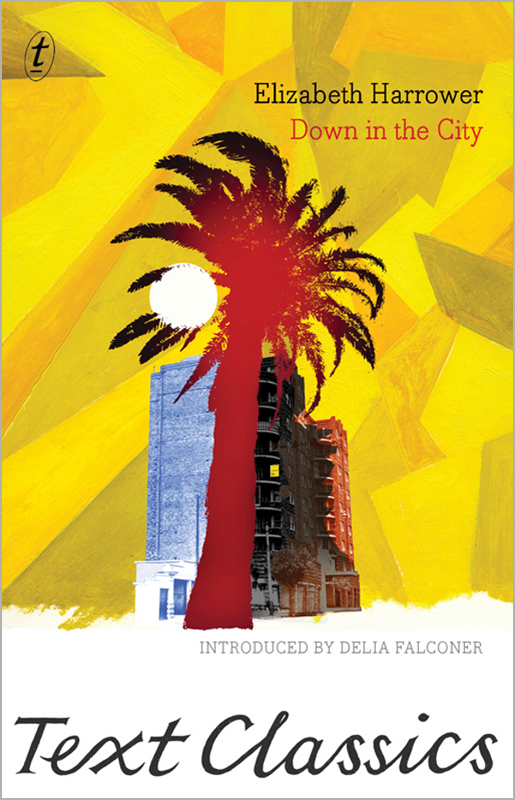Down in the City


Text Classics
ELIZABETH HARROWER
was born in Sydney in 1928 but her family soon relocated to Newcastle, where she lived until she was eleven.
In 1951 Harrower moved to London. She travelled extensively and began to write fiction. Her first novel,
Down in the City
, was published in 1957 and was followed by
The Long Prospect
a year later. In 1959 she returned to Sydney, where she began working for the AB C and as a book reviewer for the
Sydney Morning Herald
. In 1960 she published
The Catherine Wheel
, the story of an Australian law student in London, her only novel not set in Sydney.
The Watch Tower
appeared in 1966. Between 1961 and 1967 she worked in publishing, for Macmillan.
Harrower published no more novels, though she continued to write short fiction. Her work is austere, intelligent, ruthless in its perceptions about men and women. She was admired by many of her contemporaries, including Patrick White and Christina Stead, and is without doubt among the most important writers of the postwar period in Australia.
Elizabeth Harrower lives in Sydney.
DELIA FALCONER
is the author of two novels,
The Service of Clouds
(1997) and
The Lost Thoughts of Soldiers
(2005), and the memoir
Sydney
(2010). She holds a PhD in English literature and cultural studies, and is a senior lecturer at the University of Technology, Sydney.
ALSO BY ELIZABETH HARROWER
The Long Prospect
The Catherine Wheel
The Watch Tower
Down in the City
Elizabeth Harrower

textclassics.com.au
textpublishing.com.au
The Text Publishing Company
Swann House
22 William Street
Melbourne Victoria 3000
Australia
Copyright © Elizabeth Harrower 1957
Introduction copyright © Delia Falconer 2013
The moral rights of the authors have been asserted.
All rights reserved. Without limiting the rights under copyright above, no part of this publication shall be reproduced, stored in or introduced into a retrieval system, or transmitted in any form or by any means (electronic, mechanical, photocopying, recording or otherwise), without the prior permission of both the copyright owner and the publisher of this book.
First published in the United Kingdom by Cassell 1957
This edition published by The Text Publishing Company 2013
Cover design by WH Chong
Page design by Text
Typeset by Text
Primary print ISBN: 9781922147042
Ebook ISBN: 9781922148124
Author: Harrower, Elizabeth, 1928- author.
Title: Down in the city / by Elizabeth Harrower; introduced by Delia Falconer.
Series: Text classics.
Dewey Number: A823.3
CONTENTS
INTRODUCTION
Oblivion at the Edges
by Delia Falconer
Oblivion at the Edges
by Delia Falconer
DOWN in the City
is Elizabeth Harrower's debut, first published in 1957. It is easy to see it as a dress rehearsal for her darker, more contained
The Watch Tower
, the final work and acknowledged masterpiece of her four-book oeuvre. But that is to miss the novel's own particular oddness. For all its lightness, it glows with a sense of place and with layers of significance that remain tantalisingly elusive.
Esther Prescott is a Sleeping Beauty. Her mother died when she was small, and her father, for inscrutable reasons of Waspishness and wealth, has kept her hidden from the world. When we first see her she is comfortable in the âtree-lined citadel' of their Rose Bay mansion but untutored in ambition or feeling. Her older brothers have taken little interest in her. Thus, âshe was shackled from childhood with completest freedom. All guidance was determinedly withheld.'
Only the vulgar Stan Peterson can wake her from this spell, barging up the driveway one night in his âlong, heavily nickelled, American car'. (Those commas are vintage Harrower: precise, almost caressing; crisply and deceptively pleasant.) Stan is a petty racketeer in a postwar city on the make. He is also a woman-hater. But he falls instantly for Esther's calm lustre.
She, in turn, feels aroused by his attention. She would not be the first bourgeois woman to experience aggression as a call to life. For the first time in thirty-three years her hand touches another human being's: âThought and sensation, twin fireflies, flew in sparking, agitated circles.' Esther tells him her name, âand in that moment they were joined.' Within a fortnight they are married.
Like
The Watch Tower
's evil Felix, Stan is a kind of vampireâalthough, unlike Felix, he does not set out to destroy another soul. And, unlike
The Watch Tower
which takes place in the bell jar of the Neutral Bay house where Felix traps his wife, Laura, and her sister, Clare, the action of
Down in the City
unfolds in a block of flats in Kings Cross.
The area is not quite the âbright and wicked' Montmartre of Sydney the prologue promises us: the residents of Romney Court are biding their time before they can afford something better in the suburbs. Already in residence, Stan has upgraded from his ground-floor bachelor flat to a fourth-floor double with a âgreen-tiled bathroomâ¦and a balcony enclosed waist-high by a brick wall'.
For a while, Stan tries. He vows to give up his drink, his long-term girlfriend, Vi, and the dodgier aspects of his business. But soon the marriage starts to turn. Stan transgresses, blames Esther, she conciliates; he realises the power of goading her until she cracks, though this risks diminishing the reflected glamour that he basks in. He drinks and rages; they reconcile. The cycle only strengthens Esther's obsessive love. She becomes ingratiating.
Critics concentrate on Harrower's obsessive theme of toxic co-dependence (it is there, too, in
The Long Prospect
and
The Catherine Wheel
) but few tackle her preoccupation with class. Yet here, as in
The Watch Tower
, is a self-made man stripping a woman of privilege until she is his slave. Stan âwouldn't let a cold wind blow on Esther', and loves to display her in a pretty dress, but can't help chipping away at her tranquil coolness. He is, in the old coin, common.
Within a fortnight Esther is calling him âpet' and she is his âEst'. Stan is impulsive and simplistic, with a limited interior life. âPoor coot's goin' mad!' he blurts as a popular love song plays on the radio. He is feverishly envious of Esther's family, and intimidated by them into resentful fury.
As she carried the plates in and set them on the table she said, âDavid called in this afternoon. Just to see how I was,' she added when Stan made no comment.
After a long pause he said, âOh,
did
he?' and the weight of hostile insinuation in his voice made her freeze. âChecking up on his low-class brother-in-law, was he?'
âOh, Stan,' she began hopelessly, and stopped. âHere is your soup, pet. Come, have it while it's hot. It will make you feel better.'
But the worse crime in Harrower's claustrophobic fictional universe is parental neglect. Failure to imagine a child's wants, indifference to their self, sets up a child for a life of exploitation. Esther is so âirrevocably' damaged that she can't imagine her life differently; orphanage-raised Stan has no idea how to treat her. They are trapped in a folie à deux. Even so, Harrower indicates that it may be possible for Esther to find a real, if inferior, happiness with Stanâuntil her coldly controlling brother destroys it.
Down in the City
is a novel of close social observation, but other genres crowd around its central drama. Esther and Stan's marriage fails amid trips to nightclubs and seaside pools, and engagements with their up-and-coming neighbours: the Maitlands and their tiny daughter; and the Demsters, a professional golfer, his wife and their teenage niece. Childish Laura Maitland is a petty tyrant like Stan. She has taken the desperately lonely young Rachel under her wing, but picks relentlessly at her insecurities to keep the girl grateful. Esther, as much as she is able, becomes friends with both women; and, at times, the concentration on clothes, meals and polite conversation drifts into the sparkly territory of Madeleine St John's
The Women in Black
. Nor is the novel above melodrama: Stan's clinches with the tough-talking, nail-painting Vi might have come straight out of a B-grade movie.
Both narratives further erode the Sleeping Beauty fairytaleâwhich the novel seems to lose interest in after a few chapters. Rachel, palmed off on her elderly relatives by an absent father, is a double for Esther, as Laura is for Stan. But, like Clare in
The Watch Tower
, Rachel has reserves of grit that mean she won't wait passively for rescue. By sheer force of will she gets a job, and a boyfriendâa lecturer from Italy, who encourages her to educate herselfâand her liberation begins. (Clare is also saved by contact with a young foreigner: Harrower, like St John, suggests that the cosmopolitan ânew Australians' can enliven a city where the shops are closed on Sundays and oysters are eaten out of bottles.) Vi, meanwhile, is a self-made woman: her economic security means Stan can't intimidate her. Only Esther is susceptible.
But what of the novel's thrall to Sydney, whose weather and moods are so overpowering? Why does the writing light up whenever it describes the âdark, dusty bush' fringing the harbour, a coral tree âstark and glorious' or the âstrange, pink radiance' of dusk? This other emotional topography, close to the gothic in intensity, creates a second momentum in the novel that may even be more powerful than the monkey grip holding Stan and Esther. Harrower recalls:
Moving from Scotland to London in 1954, I decided to write novels. I was never homesick for Australia, but after years away I remembered Sydney with great affection and in great detail, and that was what I wanted to write about. I thought of the city in the years from 1945 till 1951, when I sailed away; I was seventeen at the end of the war and twenty-three when I left. The weather, the skies, the stars.
It would be convenient to read this jangle of fairytale, psychological thriller, social comedy and intense evocation of place as symptoms of a young writer's wonder at all the possibilities of fiction. But it is precisely these layers, each brushing uneasily against the other, that give this book its unusual and lasting power.
In the end,
Down in the City
is only so interested in its main storyline. It wants to throw bigger patterns of dark and light. Harrower's almost ecstatically restless prologue tips us off. It begins at the Heads and moves up the harbour to the Crossâonly to keep going, eavesdropping on banal conversations, shuttling back and forth between the inner city and the dizzying Pacific, until it watches the âvast black heavens overawe the earth with incandescent stars'.
It is no coincidence that Stan later finds himself on a cliff at Watsons Bay above the Pacific, that same point of âhazy infinity' where the novel started; which is also, as a young tough reminds him, Sydney's notorious suicide spot. Stan looks out toward the South Pole and decides to become a better man. Within hours he commits his pettiest betrayal.
For all its bright poise and brilliant light,
Down in the City
is unsettled, flicking constantly between the trivial and the sublime. There is no exit for its characters, except in the oblivion that hovers at its edges. Just as Rachel describes the mood between Esther and Stan as being like high-tension cables ringing above a lonely road, so Harrower's book keeps vibrating long after we close the covers.
PROLOGUE
Along the southern arm of Sydney Harbour lie the oldest and wealthiest suburbs of the city, beginning with Watsons Bay on its high narrow cliff, then, strung in a row along the waterfront and extending back from it, Vaucluse, Rose Bay, Double Bay and Rushcutters Bay. Between Rushcutters Bay and the city proper there is Kings Cross and a slum.